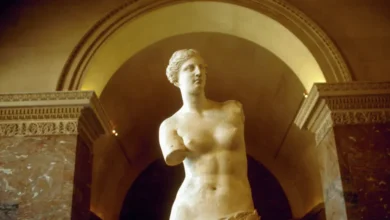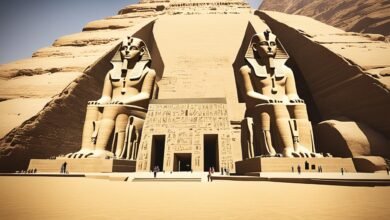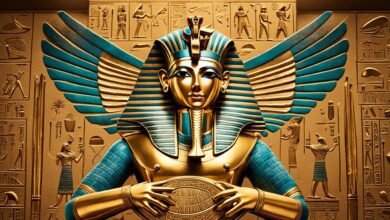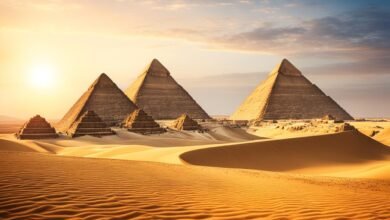Table of Contents
What secrets are hidden in the ancient tombs of the Valley of the Kings? Embark on a journey through this legendary burial ground. Discover the fascinating rituals and exquisite artifacts left for us to find.
The Valley of the Kings has fascinated people for centuries. It’s filled with hidden treasures and cryptic symbolism. From Tutankhamun’s tomb to Ramses II’s chambers, each spot tells a story. This sacred place helps us understand ancient Egyptian beliefs about the afterlife.
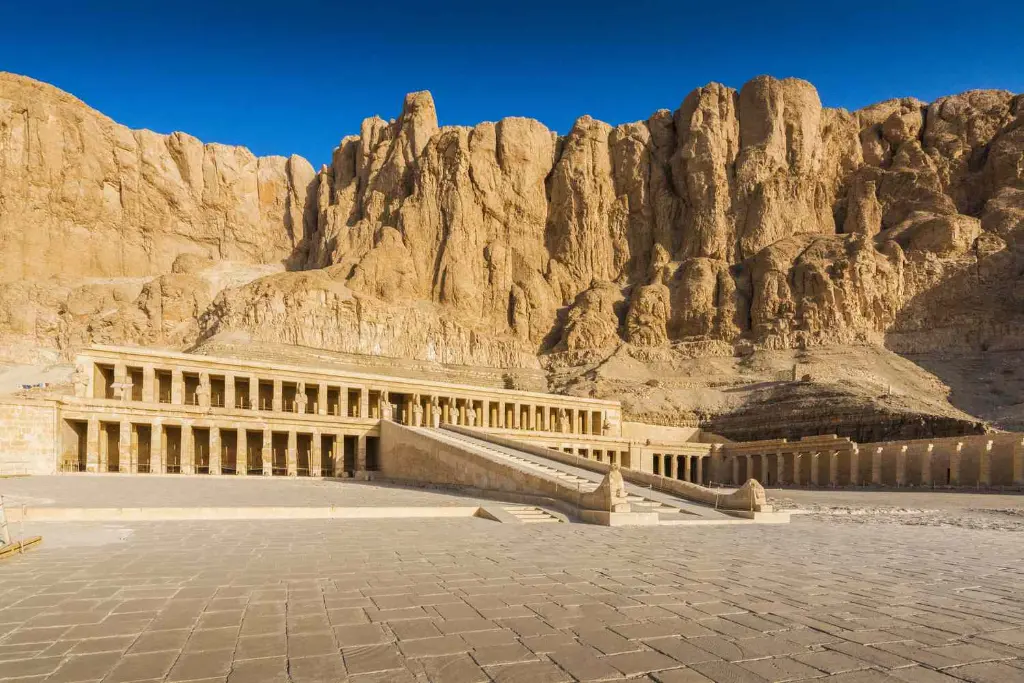
History of the Valley of the Kings
The Valley of the Kings has a rich history that began in ancient Egypt’s New Kingdom period, roughly between 1550-1070 BCE. It was chosen by pharaohs and other important people for their burials. Its location near the capital city of ancient Thebes, now Luxor, made it a perfect spot. The valley’s isolation also helped keep the tombs safe.
Building of the tombs started in the time of Thutmose I and spanned over 500 years. These tombs were made very carefully. Their design aimed to help the pharaohs have a good journey to the afterlife. This valley was key for the Egyptians to preserve their pharaohs and help them move on to the next life.
The Valley of the Kings showed how deeply Egyptians believed in life after death. The care taken in the tombs’ construction and decoration showed their strong customs. Even today, this valley draws people in with its history. It also offers a great look into ancient Egypt’s beliefs, arts, and daily life.
Tombs and Artistic Treasures of the Valley of the Kings
The Valley of the Kings hides over 60 royal tombs. Here, you can find the graves of famous pharaohs like Tutankhamun, Ramses II, and Seti I.
These tombs are covered in detailed hieroglyphics and vivid scenes. They show stories from Egyptian mythology, giving us a peek into the past.
They show religious events, battles, and afterlife rituals. These carvings reveal ancient Egyptian life and their view of the pharaohs as god-like rulers.
Inside, you’ll also find amazing treasures. Tutankhamun’s golden mask and statues are just a few examples. They show off Egypt’s rich culture and the talents of its artists.
Walking through these tombs feels like a time machine. You get a close look at ancient Egypt’s art and beliefs. It’s truly a unique experience.
A Glimpse of the Royal Tombs in the Valley:
- The Tomb of Tutankhamun (KV62) – You can see Tutankhamun’s famous golden mask here.
- The Tomb of Ramses II (KV7) – This tomb is dedicated to one of Egypt’s most powerful pharaohs.
- The Tomb of Seti I (KV17) is known for its detailed decorations and wall carvings.
These tombs give us a special look into the past. They teach us about the lives of these ancient kings and their close link to the gods.
The Golden Mask of Tutankhamun – A Masterpiece of Ancient Egyptian Art
Tutankhamun’s golden mask is a truly incredible find. It’s made of solid gold and covers the pharaoh’s mummy. Its beauty and detail are a symbol of ancient Egypt’s wealth and glory.
The mask’s hieroglyphics tell a story of protection. They emphasize the importance of visual tales in ancient Egypt. The creation of this mask shows the incredible skill of Egypt’s artisans.
Today, Tutankhamun’s mask is still a beloved symbol of ancient Egypt. Visitors are always amazed by its magnificence. It helps us understand the Valley of the Kings’ complex and fascinating history.
Discovery and Exploration of the Valley of the Kings
The Valley of the Kings is full of mysteries. For centuries, it has intrigued archaeologists and history buffs. Before 1922, experts thought they had found all the tombs, 62 in total. But in 1922, Howard Carter found something that changed everything.
Howard Carter, a British archaeologist, found the tomb of Tutankhamun. This was an amazing discovery. It revealed new secrets about the valley and its hidden treasures.
After finding Tutankhamun’s tomb, the search for more tombs continued. Then in 2005, Otto Schaden discovered KV 63. This was the first unknown tomb found since Tutankhamun’s.
In KV 63, they found ancient sarcophagi, pottery, and linens. These finds suggested there could be more tombs waiting to be discovered. People are still excited to see what else might be found in the Valley of the Kings.
Significance of Recent Discoveries
Howard Carter and Otto Schaden’s discoveries have changed our view of the Valley of the Kings. They have taught us a lot about how the ancient Egyptians buried their kings. This gives us a look into the kings’ lives after death.
The treasures from these new tombs, like Tutankhamun’s golden mask, have wowed the world. They show how rich and advanced the ancient Egyptians were. This discovery brought attention to the valley’s wonders.
These discoveries tell us that more secrets are still buried in the Valley of the Kings. Excavations are ongoing. Who knows what amazing things are still waiting to be found in this ancient place?
Significance and Symbolism of the Valley of the Kings
The Valley of the Kings is very important in ancient Egyptian culture and religion. The tombs there were made to help the pharaohs easily reach the afterlife. They thought keeping the pharaohs’ bodies safe was key. They believed the body held their soul after death.
These tombs are full of things the pharaohs might need in the next life. They had treasures and special items for the pharaohs’ use. It was very important to keep the pharaoh’s body safe. They believed a part of them, called ka, would stay with the body forever.
The ancient Egyptians saw pharaohs as almost gods. Their afterlife journey was crucial. The Valley of the Kings’ rituals show their strong belief in life after death. The grand tombs showed how important the pharaohs were. They proved the pharaohs were connected to their gods forever.
Ancient Egyptian Beliefs in the Afterlife
Ancient Egyptians felt the afterlife was like our current life. They thought the pharaoh’s body needed to be preserved for their next journey. Mummification stops the body from decaying. It’s covered with linen to keep its form.
The tombs were stocked with all the things the pharaoh might want. This includes food, clothes, furniture, and pets. They painted detailed scenes on the walls. These showed the pharaoh’s life and their relationship with the gods.
The Valley of the Kings’ design shows how the ancient Egyptians valued their pharaohs. They believed the pharaoh’s body and the things buried with them helped in the afterlife. This ensured they would reach eternal peace.
Location and Layout of the Valley of the Kings
The Valley of the Kings is found on the Nile’s west bank, near Luxor, Egypt. This site is a key part of the Theban Necropolis, home to many ancient monuments.
This valley stretches about 2 kilometers. It has the East Valley, where most visitors go, and the West Valley, quieter and less crowded. The East Valley is full of famous tombs, while the West Valley offers peace.
Imagine being in this stunning valley, surrounded by vast deserts and high mountains. Its spot next to the Nile adds to its charm. It’s a beautiful place to explore.
| Location | Valley of the Kings |
|---|---|
| Relative Location | West bank of the Nile River |
| City | Luxor |
| Complex | Theban Necropolis |
| Valley Divisions |
|
Must-Visit Attractions in the Valley of the Kings
The Valley of the Kings hides ancient wonders, letting us see Egypt’s grand past. There are amazing tombs to check out. Let’s dive into some cool places to visit there:
Tomb of Tutankhamun (KV62)
The Tomb of Tutankhamun is quite the find, also called KV62. It’s famous for holding the golden mask of Tutankhamun, a young pharaoh. There are also many treasures inside. These help us understand more about Tutankhamun.
Tomb of Ramses II (KV7)
Ramses II’s tomb, KV7, is a showcase of his rule. It has detailed carvings and hieroglyphics. These show his military victories and his links to the gods.
Tomb of Seti I (KV17)
The Tomb of Seti I, or KV17, shines with its art. Its walls are full of detailed carvings. By visiting, we can see into the ancient Egyptians’ daily beliefs and values.
Tomb of Hatshepsut (KV20)
Hatshepsut’s tomb, KV20, is where one of Egypt’s few female pharaohs rests. It shows her achievements in detailed reliefs. We learn about her important role in history.
The Ramesseum
The Ramesseum is Ramses II’s huge temple. It has a big statue of him. Visiting here helps us see how grand Ramses II’s time was in ancient Egypt.
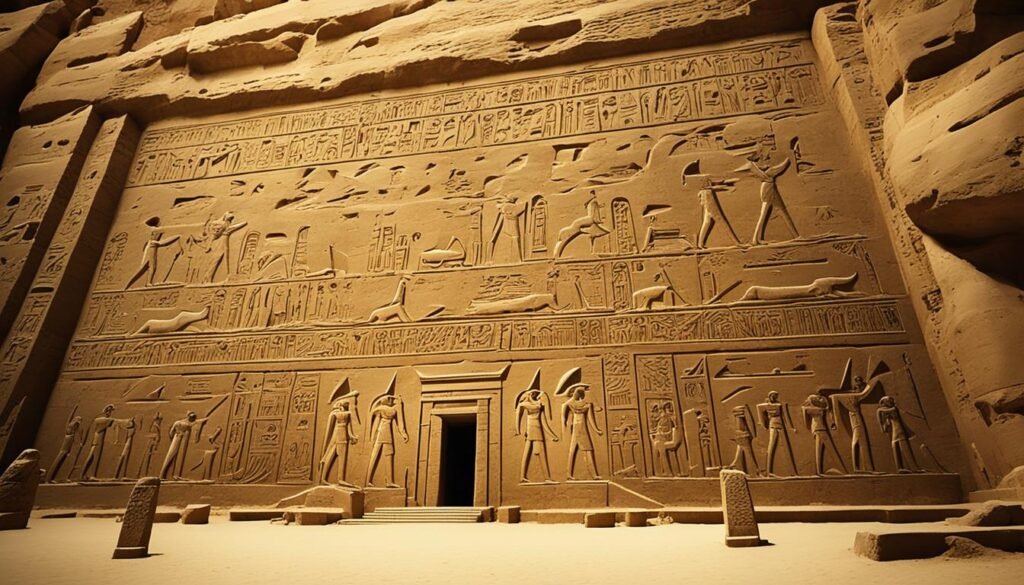
This area shows Egypt’s amazing history and art. From Tutankhamun’s riches to Hatshepsut’s legacy, there’s lots to learn. And Ramses II’s temple is a must-see for its huge statue. Visiting these places gives unforgettable experiences.
Tours and Activities in the Valley of the Kings
When visiting the Valley of the Kings, you have many tour and activity options. You can explore the history and art of each tomb. Or, you might choose to see this wonder from the sky. There’s something for anyone intrigued by this ancient place.
Guided Tomb Tours
Join expert guides to uncover the Valley of the Kings’ secrets. They offer insights into the history, art, and meaning behind each tomb. You’ll take an immersive journey through these ancient sites. It will help you understand the pharaohs’ lives and beliefs better.
Balloon Rides
A hot air balloon ride offers a unique view of the Valley of the Kings. You will see the royal tombs, temples, and the Nile River from above. This amazing adventure gives you a memorable perspective on this historic landscape
Luxor West Bank Tour
Experience the Luxor West Bank’s highlights with a visit to the Valley of the Kings and more. Explore Hatshepsut’s mortuary temple, one of Egypt’s few female pharaohs. Then, see the impressive Colossi of Memnon. Discover the Medinet Habu temple, built for Ramses III. This tour brings you closer to ancient Egyptian culture and its wonders.
Best Time to Visit the Valley of the Kings
When picking your trip to the Valley of the Kings, choose wisely. This historic site goes through extreme temperatures at times. Visiting in spring (March to May) or autumn (September to November) is best. The weather is pleasantly warm then.
Spring makes the Valley of the Kings burst with life. Flowers bloom and the weather is just right for exploring. This time, it’s not too hot or too cold. It’s perfect for discovering ancient secrets.
Autumn is also great for a visit. The summer heat fades, making it comfortable for you to see the tombs. You can enjoy the history and art without feeling too hot. Autumn’s warm, but cooler than summer.
Both spring and autumn are ideal for exploring the tombs. The weather is mild, and you can see the detailed art clearly. This makes learning about Egypt’s ancient times more enjoyable.
Plan well for a spring or autumn visit. Always check the weather forecast. This way, your time at the Valley of the Kings will be great and worry-free.
Safety and Dress Code at the Valley of the Kings
When you plan to visit the Valley of the Kings, safety and respecting local customs matter. The site is generally safe. Yet, taking basic safety steps is smart for a smooth and secure visit.
It’s important not to travel alone at night and to keep your valuables safe. Doing so cuts the chances of any trouble during your stay.
Also, dressing properly when visiting the Valley of the Kings is key. Modest dress shows respect for local ways. Plus, it makes your visit to the ancient place more comfortable.
Wear clothes that cover your arms and legs. Choose shorts or skirts that reach at least your knees. This way, you show respect and guard yourself from the strong sun.
This site is very sacred. How you dress can show respect to its cultural value.
| Safety Tips | Dress Code Guidelines |
|---|---|
| Travel in groups or with a trusted guide | Wear comfortable and modest clothing |
| Keep valuables secure and avoid displaying expensive items | Choose knee-length shorts or skirts |
| Stay in well-lit areas, especially at night | Opt for shirts or blouses with sleeves |
| Follow local laws and regulations | Avoid revealing or tight-fitting clothing |
Follow the safety and dress rules to have a deep experience at the Valley of the Kings. Enjoy your time and admire the glorious Ancient Egyptian wonders.
Accessibility and Transportation to the Valley of the Kings
Planning to visit the Valley of the Kings? It’s easy to get there from Luxor and Aswan. You can choose from private cars to public buses, fitting your budget and needs.
Driving there lets you control your time and see other sights nearby. You can take the direct route from both Luxor and Aswan.
Prefer not to drive? Buses from Luxor and Aswan are budget-friendly and comfy. You can relax on your journey there.
Do you enjoy water travel? A boat ride from Aswan to Luxor up the Nile River is an option. It not only offers beautiful views but also a little adventure.
The Valley of the Kings is surrounded by Egypt’s stunning landscapes. Getting there is straightforward with options like the car, bus, or boat. Your journey will be convenient and exciting, no matter how you travel.
Transportation Options to the Valley of the Kings:
- Car: Easily accessible via direct routes from Luxor and Aswan.
- Bus: Public buses available from Luxor and Aswan, providing a budget-friendly option.
- Boat: Scenic boat rides up the Nile River from Aswan to Luxor, offering picturesque views along the way.
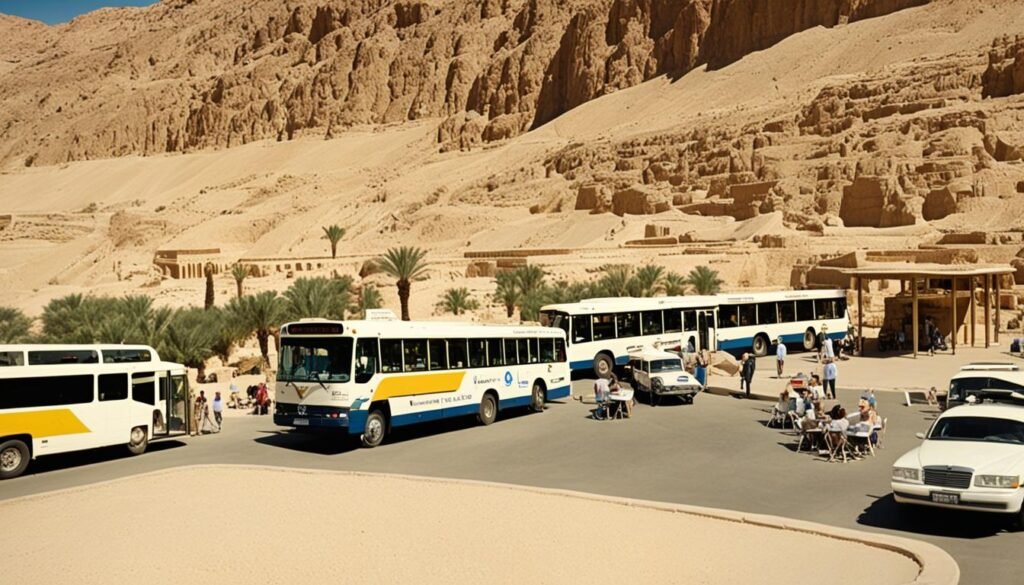
With various ways to reach the Valley of the Kings, it’s a simple trip from Luxor and Aswan. Pick the way of travel that’s just right for you. Start your journey and discover the secrets of this ancient site.
Conclusion
The Valley of the Kings in ancient Egypt shows the rich history of this amazing civilization. It lets visitors see the preserved tombs and monuments from the New Kingdom period of pharaohs and nobles. With its detailed artwork, interesting sites, and enchanting stories, the Valley of the Kings surprises people from all over.
Imagine being amazed by the gold found in Tutankhamun’s tomb, or seeing Ramses II’s grand tomb. Or reading the stories known through hieroglyphics. A visit here is unforgettable. It reveals ancient Egypt’s secrets, letting you experience its legacy and understand its mysteries.
Walking in the Valley of the Kings takes you back in time. You follow pharaohs’ paths and see the wonders of their world. You soak in the history, admire the art, and learn about their culture. It’s not just about tombs; it’s a tribute to a great civilization.
